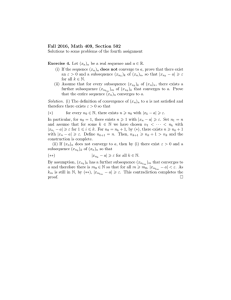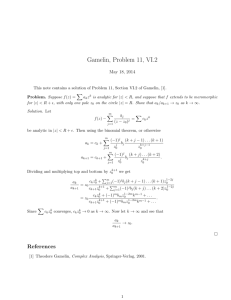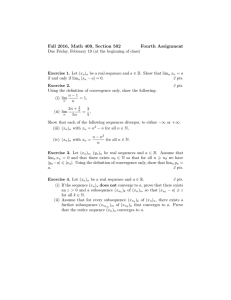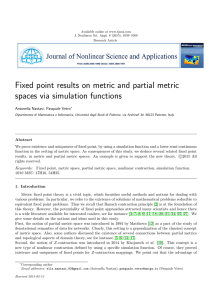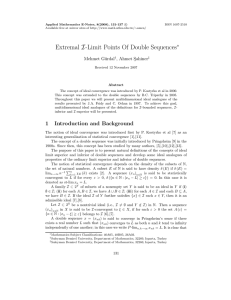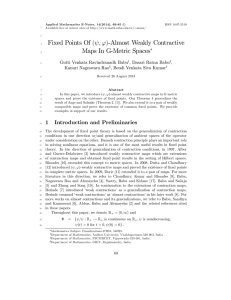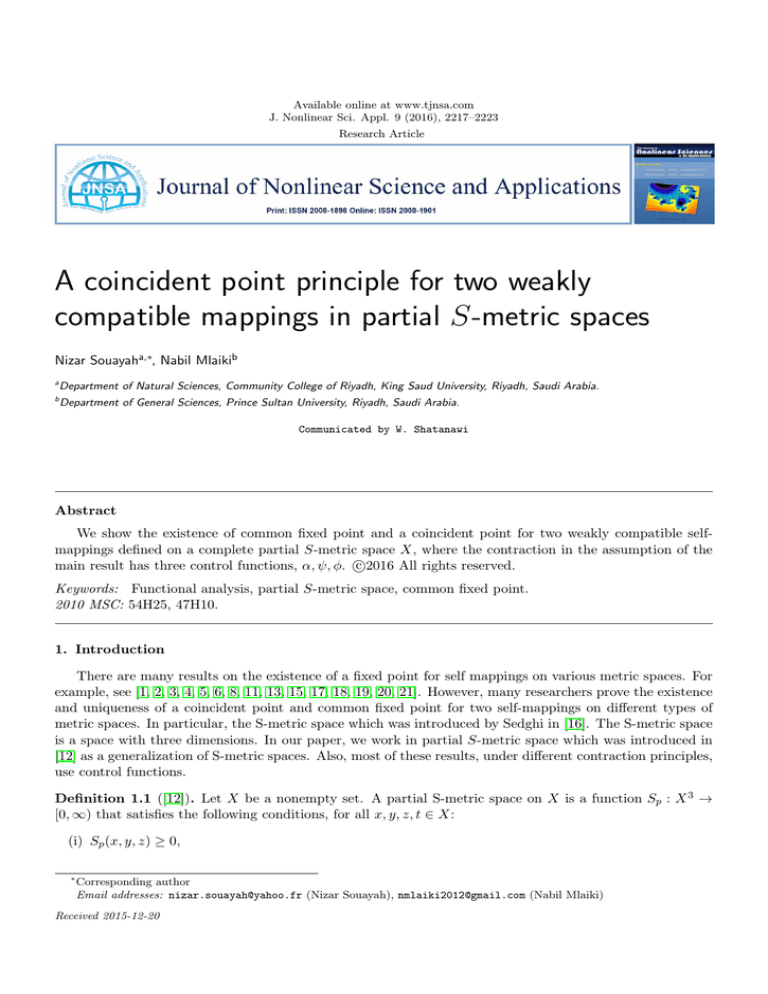
Available online at www.tjnsa.com
J. Nonlinear Sci. Appl. 9 (2016), 2217–2223
Research Article
A coincident point principle for two weakly
compatible mappings in partial S-metric spaces
Nizar Souayaha,∗, Nabil Mlaikib
a
Department of Natural Sciences, Community College of Riyadh, King Saud University, Riyadh, Saudi Arabia.
b
Department of General Sciences, Prince Sultan University, Riyadh, Saudi Arabia.
Communicated by W. Shatanawi
Abstract
We show the existence of common fixed point and a coincident point for two weakly compatible selfmappings defined on a complete partial S-metric space X, where the contraction in the assumption of the
c
main result has three control functions, α, ψ, φ. 2016
All rights reserved.
Keywords: Functional analysis, partial S-metric space, common fixed point.
2010 MSC: 54H25, 47H10.
1. Introduction
There are many results on the existence of a fixed point for self mappings on various metric spaces. For
example, see [1, 2, 3, 4, 5, 6, 8, 11, 13, 15, 17, 18, 19, 20, 21]. However, many researchers prove the existence
and uniqueness of a coincident point and common fixed point for two self-mappings on different types of
metric spaces. In particular, the S-metric space which was introduced by Sedghi in [16]. The S-metric space
is a space with three dimensions. In our paper, we work in partial S-metric space which was introduced in
[12] as a generalization of S-metric spaces. Also, most of these results, under different contraction principles,
use control functions.
Definition 1.1 ([12]). Let X be a nonempty set. A partial S-metric space on X is a function Sp : X 3 →
[0, ∞) that satisfies the following conditions, for all x, y, z, t ∈ X:
(i) Sp (x, y, z) ≥ 0,
∗
Corresponding author
Email addresses: nizar.souayah@yahoo.fr (Nizar Souayah), nmlaiki2012@gmail.com (Nabil Mlaiki)
Received 2015-12-20
N. Souayah, N. Mlaiki, J. Nonlinear Sci. Appl. 9 (2016), 2217–2223
2218
(ii) x = y if and only if Sp (x, x, x) = Sp (y, y, y) = Sp (x, x, y),
(iii) Sp (x, y, z) ≤ Sp (x, x, t) + Sp (y, y, t) + Sp (z, z, t) − Sp (t, t, t),
(iv) Sp (x, x, x) ≤ Sp (x, y, z),
(v) Sp (x, x, y) = Sp (y, y, x).
The pair (X, Sp ) is called a partial S-metric space.
Next, we recall some basic definitions for the convenience of readers.
Definition 1.2 ([12]). A sequence {xn }∞
n=0 of elements in X is called p-Cauchy if limn,m Sp (xn , xn , xm ) exists
and is finite. A partial S-metric space (X, Sp ) is called complete if for each p-Cauchy sequence {xn }∞
n=0 there
exists a z ∈ X such that
Sp (z, z, z) = lim Sp (z, z, xn ) = lim Sp (xn , xn , xm ).
n
n,m
A sequence {xn }n in a partial S-metric space (X, Sp ) is called 0-Cauchy if
limn,m Sp (xn , xn , xm ) = 0.
We say that (X, Sp ) is 0-complete if every 0-Cauchy sequence in X converges to a point x ∈ X such that
Sp (x, x, x) = 0.
Definition 1.3 ([7]). A function ψ : [0, ∞)2 → [0, ∞) is said to be a generalized altering distance function
of two variables if:
1. ψ is continuous,
2. ψ is monotone increasing in both variables,
3. ψ(x, y) = 0 only if x = y = 0.
The class of all such functions is denoted by Ω. We define α(x) = ψ(x, x) for x ∈ [0, ∞). Clearly,
α(x) = 0 if and only if x = 0.
Definition
1.4 ([14]). Let X be a nonempty set, n a positive integer and F : X → X a mapping.
Sn
X = i=1 Ai is said to be a cyclic representation of X with respect to F if:
1. Ai , i = 1, 2, . . . , n are nonempty sets,
2. F (A1 ) ⊂ A2 , F (A2 ) ⊂ A3 , . . . , F (An−1 ) ⊂ An , F (An ) ⊂ A1 .
Definition
1.5 ([10]). Let X be a nonempty set, n a positive integer and f, g : X → X two mappings.
S
X = ni=1 Ai is said to be a cyclic representation of X with respect to f and g if:
1. Ai , i = 1, 2, . . . , n are nonempty sets,
2. g(A1 ) ⊂ f (A2 ), g(A2 ) ⊂ f (A3 ), . . . , g(An−1 ) ⊂ f (An ), g(An ) ⊂ f (A1 ).
Definition 1.6 ([9]). Let f and g be two self-maps on X. If f w = gw = z, for some w ∈ X, then w is
called a coincidence point of f and g, and z is called a point of coincidence of f and g. If w = z, then z is
called a common fixed point of f and g.
Definition 1.7 ([9]). Consider two self-maps f and g defined on a nonempty set X. If f gx = gf x, for all
x ∈ X, then f and g are said to be commuting maps. If they commute only at their coincidence points,
then they are said to be weakly compatible, that is, if f gx = gf x, whenever, f x = gx.
N. Souayah, N. Mlaiki, J. Nonlinear Sci. Appl. 9 (2016), 2217–2223
2219
2. Main result
In this section, we prove our main result with very useful corollary.
Theorem 2.1.
Sn0 Let (X, Sp ) be a 0-complete partial S-metric space and A1 , .S. n. ,0 An0 a nonempty subset of X,
where X = i=1 Ai . Let f, g : X → X be two self-mappings such that X = i=1 Ai is a cyclic representation
of X with respect to f and g. For any x ∈ Ai and y ∈ Ai+1 we have
α(Sp (gx, gx, gy)) ≤ ψ(Sp (f x, f x, f y), Sp (f x, f x, gx)) − φ(Sp (f x, f x, f y), Sp (f x, f x, gx)),
where An+1 = A1 , ψ, φ ∈ Ω and α(x) = ψ(x, x) for x ∈T[0, ∞). Suppose that f (Ai ), for all i are closed
0
Ai such that f z = gz. In particular, if f and
subsets of X. If fn is one-to-one, then there exists a z ∈ ni=1
g are weakly compatible, then they have a unique common fixed point.
Proof. Let x1 ∈ A1 ; then by the cyclic representation of X, we can find an element x2 ∈ A2 such that
gx1 = f x2 . Also, for x2 we can find an x3 ∈ A3 such that gx2 = f x3 . Continuing this process, we construct
the sequence {xn } defined by gxn = f xn+1 for all natural numbers n.
First, assume there exists a natural number k such that f xk = f xk+1 , hence f xn+1 = gxn . It follows
that xk is a coincidence point of f and g.
Now, suppose that f xn+1 6= f xn for all n. Then by the definition of X, there exists an im ∈ {1, 2, . . . , n}
such that xn ∈ Aim +1 and xn−1 ∈ Aim . Thus, we have
α(Sp (gxn , gxn , gxn−1 )) ≤ ψ(Sp (f xn , f xn , f xn−1 ), Sp (f xn , f xn , gxn ))
− φ(Sp (f xn , f xn , f xn−1 ), Sp (f xn , f xn , gxn )),
α(Sp (f xn+1 , f xn+1 , f xn )) ≤ ψ(Sp (f xn , f xn , f xn−1 ), Sp (f xn , f xn , f xn+1 ))
− φ(Sp (f xn , f xn , f xn−1 ), Sp (f xn , f xn , f xn+1 ))
(2.1)
≤ ψ(Sp (f xn , f xn , f xn−1 ), Sp (f xn , f xn , f xn+1 )).
Assuming α(x) = ψ(x, x), we deduce that
ψ(Sp (f xn+1 , f xn+1 , f xn ), Sp (f xn+1 , f xn+1 , f xn )) ≤ ψ(Sp (f xn , f xn , f xn−1 ), Sp (f xn+1 , f xn+1 , f xn )).
If Sp (f xn , f xn , f xn−1 ) < Sp (f xn+1 , f xn+1 , f xn ), then
α(Sp (f xn+1 , f xn+1 , f xn )) ≤ ψ(Sp (f xn , f xn , f xn−1 ), Sp (f xn+1 , f xn+1 , f xn ))
< ψ(Sp (f xn+1 , f xn+1 , f xn ), Sp (f xn+1 , f xn+1 , f xn ))
= α(Sp (f xn+1 , f xn+1 , f xn )),
which leads to a contradiction, because we know that α is monotone increasing and Sp (f xn+1 , f xn+1 , f xn ) 6=
0 and hence α(Sp (f xn+1 , f xn+1 , f xn )) 6= 0. Therefore, Sp (f xn+1 , f xn+1 , f xn ) ≤ Sp (f xn , f xn , f xn−1 ). Thus
{Sp (f xn+1 , f xn+1 , f xn )}n≥1 is a decreasing sequence of nonnegative real numbers, so there exists an r ≥ 0,
such that
Sp (f xn+1 , f xn+1 , f xn ) → r as n → ∞.
Taking the limit as n → ∞ in inequality (2.1), we obtain:
α(r) ≤ ψ(r, r) − φ(r, r) < ψ(r, r) = α(r).
Hence, α(r) = 0 which implies that r = 0. Therefore, limn→∞ Sp (f xn , f xn , f xn+1 ) = 0.
To show that {f xn }n≥1 is a 0-Cauchy sequence, assume that {f xn }n≥1 is not. Hence, there would exists
an ε > 0 for which we can find subsequences {f xnk } and {f xmk } of {f xn } with nk > mk > k such that
Sp (f xmk , f xmk , f xnk ) ≥ ε.
N. Souayah, N. Mlaiki, J. Nonlinear Sci. Appl. 9 (2016), 2217–2223
2220
Choose nk and mk to be the smallest integers satisfying the above inequality. Thus,
Sp (f xmk , f xmk , f xnk ) ≥ ε.
Notice that
Sp (f xmk , f xmk , f xnk ) ≤ Sp (f xmk , f xmk , f xnk −1 ) + 2Sp (f xnk , f xnk , f xnk −1 )
< ε + 2Sp (f xnk −1 , f xnk −1 , f xnk ).
Thus
ε ≤ Sp (f xmk , f xmk , f xnk ) < ε,
which leads to a contradiction.
Thus, {f xn } is a 0-Cauchy sequence. Since (X, Sp ) is 0-complete, there exists a z ∈ X such that
limn→∞ Sp (f xn , f xn , z) = 0. Hence,
Sp (z, z, z) = lim Sp (f xn , f xn , z) = lim Sp (f xn , f xn , f xm ) = 0.
n→∞
n→∞
Therefore, f xn → z as n → ∞ in the partial S-metric space (X, Sp ). Since all of f (Ai ) are closed in X, so
z ∈ f (Ai ) for all
T i.
Thus, z ∈ ni=1 f (Ai ) and there exists a zi ∈ Ai such that f zi = z. Also, we know that f is a one-to-one
map, so T
we have f z1 = f z2 = · · · = f zn = z which implies that z1 = z2 = · · · = zn = z 0 . Therefore, f z 0 = z
for z 0 ∈ ni=1 Ai and limn→∞ f xn = z = f z 0 .
Now, fix i ∈ {1, . . . , n} such that z ∈ Ai and gz ∈ Ai+1 . Take a subsequence {f xnk } of {f xn } withf xnk ∈
f (Ai−1 ) where xnk ∈ Ai−1 and also converge to z. Thus,
Sp (z, z, z) = lim Sp (f xn , f xn , z) = lim Sp (f xnk , f xnk , z) = 0,
n→∞
n→∞
α(Sp (gz 0 , gz 0 , gxnk )) = α(Sp (gz 0 , gz 0 , f xnk+1 ))
≤ ψ(Sp (f z 0 , f z 0 , f xnk ), Sp (f z 0 , f z 0 , gz 0 ))
− φ(Sp (f z 0 , f z 0 , f xnk ), Sp (f z 0 , f z 0 , gz 0 )).
Taking the limit as n → ∞ and using the properties of ψ and φ, we have
ψ(Sp (gz 0 , gz 0 , f z 0 ), Sp (gz 0 , gz 0 , f z 0 )) = α(Sp (gz 0 , gz 0 , f z 0 ))
≤ ψ(Sp (f z 0 , f z 0 , f z 0 ), Sp (f z 0 , f z 0 , gz 0 ))
− φ(Sp (f z 0 , f z 0 , f z 0 ), Sp (f z 0 , f z 0 , gz 0 ))
≤ ψ(Sp (f z 0 , f z 0 , f z 0 ), Sp (f z 0 , f z 0 , gz 0 )).
Since ψ is monotone increasing, we get
Sp (gz 0 , gz 0 , f z 0 ) ≤ Sp (f z 0 , f z 0 , f z 0 ).
But, by the property of partial S-metric spaces, we have
Sp (f z 0 , f z 0 , f z 0 ) ≤ Sp (gz 0 , gz 0 , f z 0 ).
Thus
Sp (f z 0 , f z 0 , f z 0 ) = Sp (gz 0 , gz 0 , f z 0 ).
If Sp (f z 0 , f z 0 , f z 0 ) 6= 0, then Sp (f z 0 , f z 0 , f z 0 ) > 0 and
N. Souayah, N. Mlaiki, J. Nonlinear Sci. Appl. 9 (2016), 2217–2223
2221
ψ(Sp (f z 0 , f z 0 , f z 0 ), Sp (f z 0 , f z 0 , f z 0 )) = α(Sp (f z 0 , f z 0 , f z 0 ))
≤ ψ(Sp (f z 0 , f z 0 , f z 0 ), Sp (f z 0 , f z 0 , f z 0 ))
− φ(Sp (f z 0 , f z 0 , f z 0 ), Sp (f z 0 , f z 0 , gz 0 ))
≤ ψ(Sp (f z 0 , f z 0 , f z 0 ), Sp (f z 0 , f z 0 , f z 0 )).
Given the fact that ψ, φ ∈ Ω, this leads to a contradiction. Thus
Sp (f z 0 , f z 0 , f z 0 ) = Sp (gz 0 , gz 0 , f z 0 ) = Sp (gz 0 , gz 0 , gz 0 ) = 0
and gz 0 = f z 0 = z.
Since f and g are weakly compatible, we have ggz 0 = gf z 0 = f f z 0 , that is f z = gz.
Now,
we show that f z = z. Since gz 0 ∈ X, we have gz 0 ∈ Ai for some i ∈ {1, . . . , n}. We know that
T
z 0 ∈ ni=1 Ai , so we have z 0 ∈ Ai−1 and
α(Sp (gz 0 , gz 0 , ggz 0 )) ≤ ψ(Sp (f z 0 , f z 0 , f gz 0 ), Sp (gz 0 , gz 0 , gz 0 ))
− φ(Sp (f z 0 , f z 0 , f gz 0 ), Sp (f z 0 , f z 0 , gz 0 ))
≤ ψ(Sp (f z 0 , f z 0 , f gz 0 ), Sp (f z 0 , f z 0 , gz 0 )).
Since f z 0 = gz 0 , we deduce
α(Sp (gz 0 , gz 0 , ggz 0 )) ≤ ψ(Sp (gz 0 , gz 0 , ggz 0 ), Sp (gz 0 , gz 0 , gz 0 ))
− φ(Sp (gz 0 , gz 0 , ggz 0 ), Sp (gz 0 , gz 0 , gz 0 ))
≤ ψ(Sp (gz 0 , gz 0 , ggz 0 ), Sp (gz 0 , gz 0 , gz 0 ))
≤ ψ(Sp (gz 0 , gz 0 , ggz 0 ), Sp (gz 0 , gz 0 , ggz 0 )).
Since ψ ∈ Ω and Sp (gz 0 , gz 0 , gz 0 ) ≤ Sp (gz 0 , gz 0 , ggz 0 ), we have
Sp (gz 0 , gz 0 , ggz 0 ) = 0,
and hence, gz = gz 0 = ggz 0 = gz = f z. Thus f z = gz = z.
Now, assume that there exists another common fixed point z ∗ ∈ X of f and g. Hence,
α(Sp (z, z, z ∗ )) = α(Sp (gz, gz, gz ∗ ))
≤ ψ(Sp (f z, f z, f z ∗ ), Sp (f z, f z, gz))
− φ(Sp (f z, f z, f z ∗ ), Sp (f z, f z, gz))
≤ ψ(Sp (f z, f z, f z ∗ ), Sp (f z, f z, gz))
= ψ(Sp (z, z, z ∗ ), Sp (z, z, z)).
Since ψ ∈ Ω and Sp (z, z, z) ≤ Sp (z, z, z ∗ ), therefore Sp (z, z, z ∗ ) = 0 and hence z = z ∗ , as desired.
Now, we state the following immediate corollary.
Corollary 2.2. Let (X, Sp ) be a complete partial
Sn S-metric space, n a positive integer, and A1 , · · · , An
nonempty closed subsets of X such that X = 1 Ai is a cyclic representation of X with respect to the
self-mapping g on X. Assume that there exist ψ, φ ∈ Ω such that
α(Sp (gx, gx, gy)) ≤ ψ(Sp (x, x, y), Sp (x, x, gx)) − φ(Sp (x, x, y), Sp (x, x, gx))
is satisfied for any x ∈ Ai and y ∈ Ai+1 for i ∈ T
{1, · · · , n}, where An+1 = A1 , and for x ∈ [0, ∞),
α(x) = ψ(x, x). Then g has a unique fixed point z ∈ n1 Ai .
Proof. Just take f x = x in Theorem 2.1.
N. Souayah, N. Mlaiki, J. Nonlinear Sci. Appl. 9 (2016), 2217–2223
2222
Example 2.3. Let X = [0, 1] and define the function Sp : X × X × X → R+ by Sp (x, y, z) = max(x, y, z).
2
Then (X, Sp ) is a complete partial S-metric space. Let f, g : X → X be such that f x = x4 and gx = x16 for
all x ∈ X. Let ψ, φ ∈ Ω be defined by ψ(x, y) = x + y and φ(x, y) = max(x, y) for all x, y, z ∈ [0, ∞). Let
Ai = [0, 1] for i = 1, 2, . . . , n.
T
Note that all the conditions of Theorem 2.1 are satisfied and we obtain 0 ∈ ni=1 Ai as coincident and
common fixed point of f and g.
3. Conclusion
In closing, the authors invite the readers to try to prove our main result, weakening or eliminating the
assumption that f and g are weakly compatible. Also, it is possible to prove a similar result if we change
the contraction to
α(x, y)Sp (gx, gx, gy) ≤ ψ(Sp (f x, f x, f y), Sp (f x, f x, gx)),
where ψ as defined in our main theorem and α : X × X → (0, ∞).
Acknowledgement
The authors express their appreciation to the Deanship of Scientific Research at King Saud University,
Saudi Arabia, for supporting this research work.
References
[1] M. Abbas, W. Shatanawi, T. Nazir, Common coupled coincidence and coupled fixed point of c-contractive mappings
in generalized metric spaces, Thai J. Math., 13 (2015), 337–351. 1
[2] T. Abdeljawad, Fixed points for generalized weakly contractive mappings in partial metric spaces, Math. Comput.
Modelling, 54 (2011), 2923–2927. 1
[3] T. Abdeljawad, Meir-Keeler alpha-contractive fixed and common fixed point theorems, Fixed Point Theory Appl.,
2013 (2013), 10 pages. 1
[4] T. Abdeljawad, J. O. Alzabut, E. Mukheimer, Y. Zaidan, Best proximity points for cyclical contraction mappings
with 0-boundedly compact decompositions, J. Comput. Anal. Appl., 15 (2013), 678–685. 1
[5] T. Abdeljawad, K. Dayeh, N. Mlaiki, On fixed point generalizations to partial b-metric spaces, J. Comput. Anal.
Appl., 19 (2015), 883–891. 1
[6] T. Abdeljawad, E. Karapinar, K. Taş, A generalized contraction principle with control functions on partial metric
spaces, Comput. Math. Appl., 63 (2012), 716–719. 1
[7] B. S. Choudhury, P. N. Dutta, A unified fixed point result in metric spaces involving a two variable function,
Filomat, 14 (2000), 43–48. 1.3
[8] L. Gholizadeh, A fixed point theorem in generalized ordered metric spaces with application, J. Nonlinear Sci. Appl.,
6 (2013), 244–251. 1
[9] G. Jungck, Compatible mappings and common fixed points, Internat. J. Math. Math. Sci., 9 (1986), 771–779. 1.6,
1.7
[10] E. Karapinar, N. Shobkolaei, S. Sedghi, S. M. Vaezpour, A common fixed point theorem for cyclic operators on
partial metric spaces, Filomat, 26 (2012), 407–414. 1.5
[11] H. P. Masiha, F. Sabetghadam, N. Shahzad, Fixed point theorems in partial metric spaces with an application,
Filomat, 27 (2013), 617–624. 1
[12] N. Mlaiki, A contraction principle in partial S-metric space, Univ. J. Math. Math. Sci., 5 (2014), 109–119. 1, 1.1,
1.2
[13] S. Oltra, O. Valero, Banach’s fixed point theorem for partial metric spaces, Rend. Istit. Mat. Univ. Trieste, 36
(2004), 17–26. 1
[14] I. A. Rus, Cyclic representations and fixed point, Ann. Tiberiu Popoviciu Semin. Funct. Equ. Approx. Convexity,
3 (2005), 171–178. 1.4
[15] B. Samet, C. Vetro, P. Vetro, Fixed point theorems for α-ψ-contactive type mappings, Nonlinear Anal., 75 (2012),
2154–2165. 1
[16] S. Sedghi, N. Shobe, A. Aliouche, A generalization of fixed point theorems in S-metric spaces, Mat. Vesn., 64
(2012), 258–266. 1
[17] W. Shatanawi, E. Karapinar, H. Aydi, Coupled coincidence points in partially ordered cone metric spaces with a
c-distance, J. Appl. Math., 2012 (2012), 15 pages. 1
N. Souayah, N. Mlaiki, J. Nonlinear Sci. Appl. 9 (2016), 2217–2223
2223
[18] W. Shatanawi, A. Pitea, Some coupled fixed point theorems in quasi-partial metric spaces, Fixed Point Theory
Appl., 2013 (2013), 15 pages. 1
[19] W. Shatanawi, M. Postolache, Some fixed-point results for a G-weak contraction in G-metric spaces, Abstr. Appl.
Anal., 2012 (2012), 19 pages. 1
[20] O. Valero, On Banach fixed point theorems for partial metric spaces, Appl. Gen. Topol., 6 (2005), 229–240. 1
[21] C.Vetro, S. Chauhan, E. Karapinar, W. Shatanawi, Fixed points of weakly compatible mappings satisfying generalized ϕ-weak contractions, Bull. Malays. Math. Sci. Soc., 38 (2015), 1085–1105. 1


